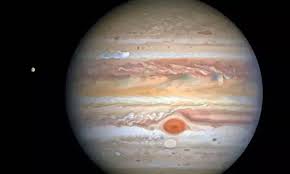Hubble finds evidence of water vapor on Jupiter

Astronomers using NASA’s Hubble Space Telescope have uncovered evidence of water vapor in the atmosphere of Jupiter’s moon Ganymede for the first time. This water vapor is formed when ice rises from the surface of the Moon, i.e. changes from solid to gas. The findings have been published in the journal Nature Astronomy.
Previous research has offered circumstantial evidence that Ganymede, the largest moon in the Solar System, contains more water than all of Earth’s oceans.
However, the temperature there is so cold that water freezes on the surface. Ganymede’s ocean will remain about 100 miles below the crust; Therefore, the water vapor would not represent the evaporation of this ocean. To find this evidence of water vapor, astronomers have re-examined Hubble observations from the past two decades.
They found that there was hardly any atomic oxygen in Ganymede’s atmosphere.
The surface temperature of Ganymede varies greatly throughout the day and around noon near the equator it can become sufficiently warm as the surface of the ice releases some small amounts of water molecules.
Roth said, it occurs when charged particles destroy the surface of the ice. The water vapor that we have now measured is produced by ice mass formation due to the thermal escape of water vapor from warm icy regions.
The discovery adds to the anticipation for the European Space Agency’s upcoming mission, JUSSI, to the Jupiter IC Moon Explorer. Jussie is planned to launch in 2022 and Jupiter’s arrival in 2029. It will make detailed observations of Jupiter and its three largest moons in at least three years, with a special emphasis on Ganymede as a planetary body and potential habitat.
Currently, NASA’s Juno mission is keeping a close eye on Ganymede and recently released new imagery of the icy moon. Juno has been studying Jupiter and its environment, also known as the Jovian system, since 2016.







